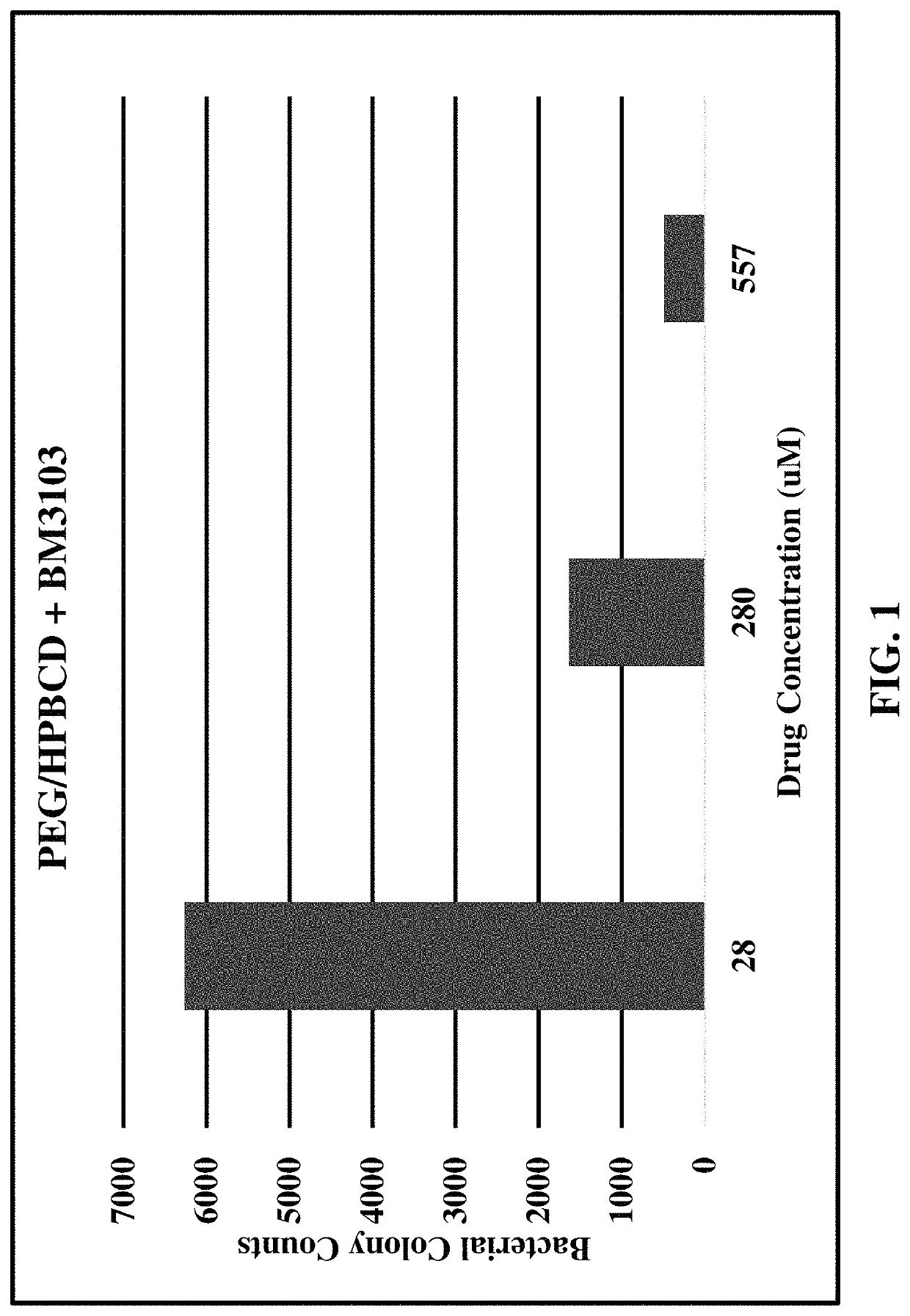Substituted tolans for the modulation of microbial colonization
a technology of microbial colonization and tolans, applied in the field of microbiology, can solve the problems of food-borne illness, inability to accept consumers, and inability to detect microbial contamination, and achieve the effect of reducing the risk of food-borne illness and reducing the risk of contamination
- Summary
- Abstract
- Description
- Claims
- Application Information
AI Technical Summary
Benefits of technology
Problems solved by technology
Method used
Image
Examples
examples 1-5
inding Colony Forming Assay
[0075]A series of dose range finding assays were performed with five bacterial strains, S. typhimurium TA97a, TA98, TA100, TA1535, and E. coli WP2 uvrA pKM101, with and without metabolic activation at three plates per dose. The following doses, along with positive and negative controls, were tested: 5000, 2500, 1250, 500, 250, 125, 50, 20, 10, 5, 2, 1, and 0.2 μg / plate. The plates were evaluated for toxicity (a decrease in plate counts with increasing dose and / or a visible thinning of the background lawn) and for precipitation of the test article. Metabolic activation was included in some samples by adding phenobarbital / benzoflavone-induced rat liver S9 fractions with cofactors (S9 mix). Prior to use, freshly thawed aliquots of rat liver S9 were mixed with a sterile cofactor mix. The S9 mix contains a 10% liver S9 concentration and was refrigerated or stored on ice until used. When testing with metabolic activation, the S9 mix was used in the assay tube in...
examples 6-9
lony Forming Assay
[0084]NEB 5 α competent E. coli were retrieved from frozen cultures and grown overnight in a bacterial incubator at 37° C. Proliferating cultures of bacteria were used in a colony forming assay by adding 25 μL of bacteria from the overnight culture to 10 mL of fresh Lysogeny Broth (LB; Bertani, G. (2004). “Lysogeny at mid-twentieth century: P1, P2, and other experimental systems”. Journal of Bacteriology. 186 (3): 595-600. PMC 321500. PMID 14729683. doi:10.1128 / JB.186.3.595-600.2004). 1 mL of this diluted bacteria was added to various dilutions of formulations of substituted tolan compounds as described in Table C, below and in charts of the corresponding Figures.
[0085]
TABLE CFormulations of Tolan CompoundsTolan*Data ExampleCompoundFormulationFigure6BM310330% PEG-400 and up to 28% HPβCD 1(hydroxypropyl-β-cyclodextrin) in water with serial dilutions of compound BM3103 mixed into a 70% volume / volume alcohol gel7BM310370% volume / volume alcohol gel28BM321370% volume / vo...
example 13
00
MRSA Inoculum
[0095]Proliferating cultures of Methicillin Resistant Staphylococcus aureus (MRSA, USA 400) were used in a colony forming assay. Frozen stock cultures of MRSA USA 400 were thawed and grown overnight in tryptic soy broth (TSB) with shaking at 37° C. The overnight culture (0.5-1.0 mL) was added to 100 mL TSB and grown at 37° C. with shaking and monitored for an optical density of 0.55-0.60 in order to obtain a final inoculum suspension of approximately 108 CFU / mL.
Alcohol Gel Formulation
[0096]BM3103 was suspended into a 70% v / v alcohol gel formulation to acquire the desired % w / v tested within the example. Each concentration was vortexed thoroughly until dissolved. Initial tested concentrations of BM3103 were 1, 0.5, and 0.1% w / v. These concentrations and the alcohol gel vehicle were mixed with equal parts of the 108 CFU / mL inoculum to obtain a final concentration of 0.5, 0.25, and 0.05% (22 mM, 11 mM, and 2 mM) BM3103. Tobramycin (600 μg / mL) served as the positive contr...
PUM
| Property | Measurement | Unit |
|---|---|---|
| weight percent | aaaaa | aaaaa |
| concentrations | aaaaa | aaaaa |
| concentrations | aaaaa | aaaaa |
Abstract
Description
Claims
Application Information
 Login to View More
Login to View More - R&D
- Intellectual Property
- Life Sciences
- Materials
- Tech Scout
- Unparalleled Data Quality
- Higher Quality Content
- 60% Fewer Hallucinations
Browse by: Latest US Patents, China's latest patents, Technical Efficacy Thesaurus, Application Domain, Technology Topic, Popular Technical Reports.
© 2025 PatSnap. All rights reserved.Legal|Privacy policy|Modern Slavery Act Transparency Statement|Sitemap|About US| Contact US: help@patsnap.com



